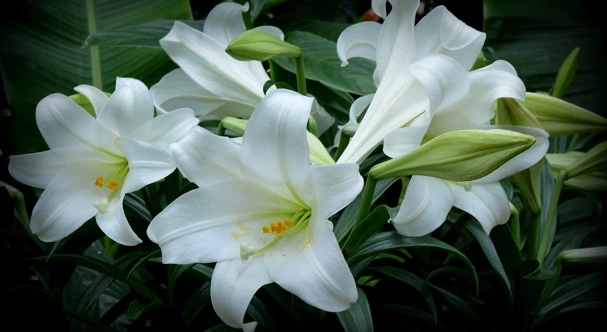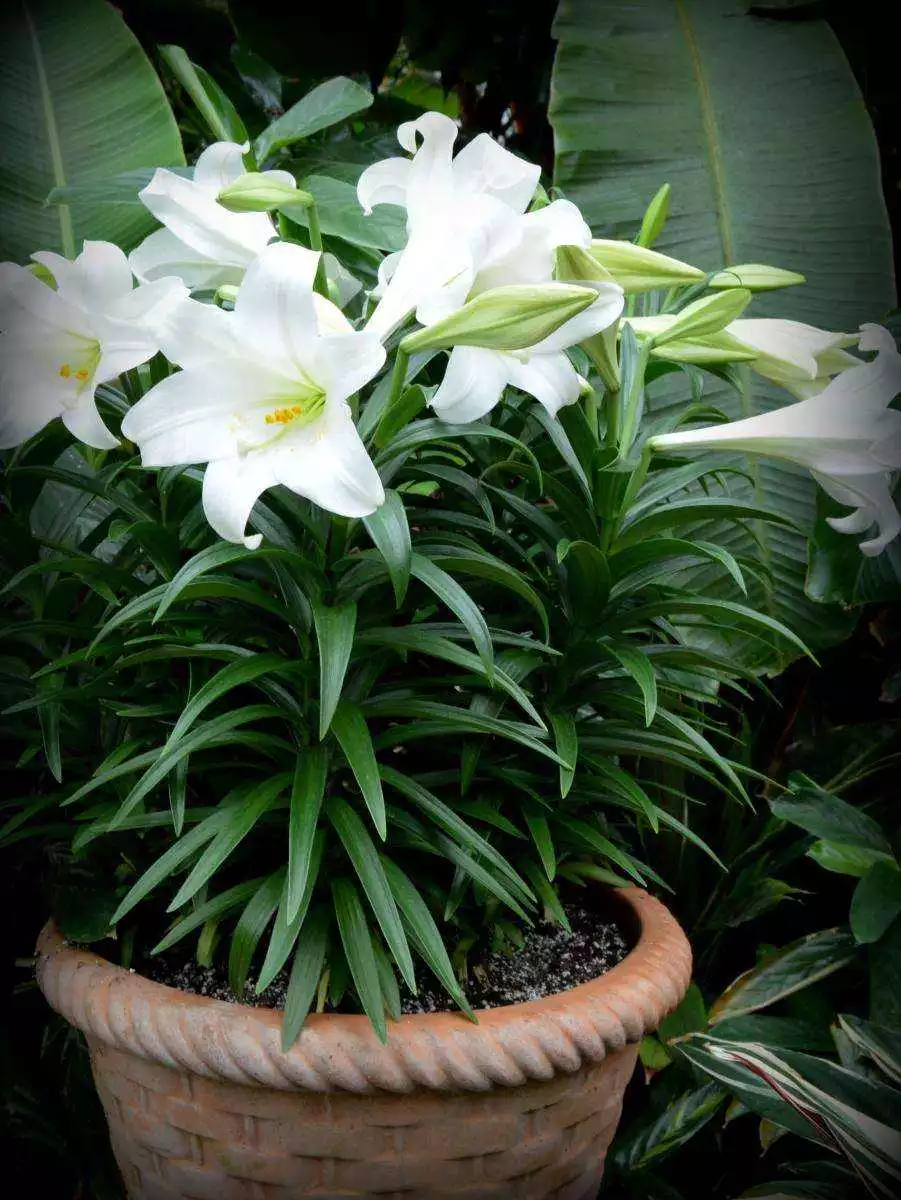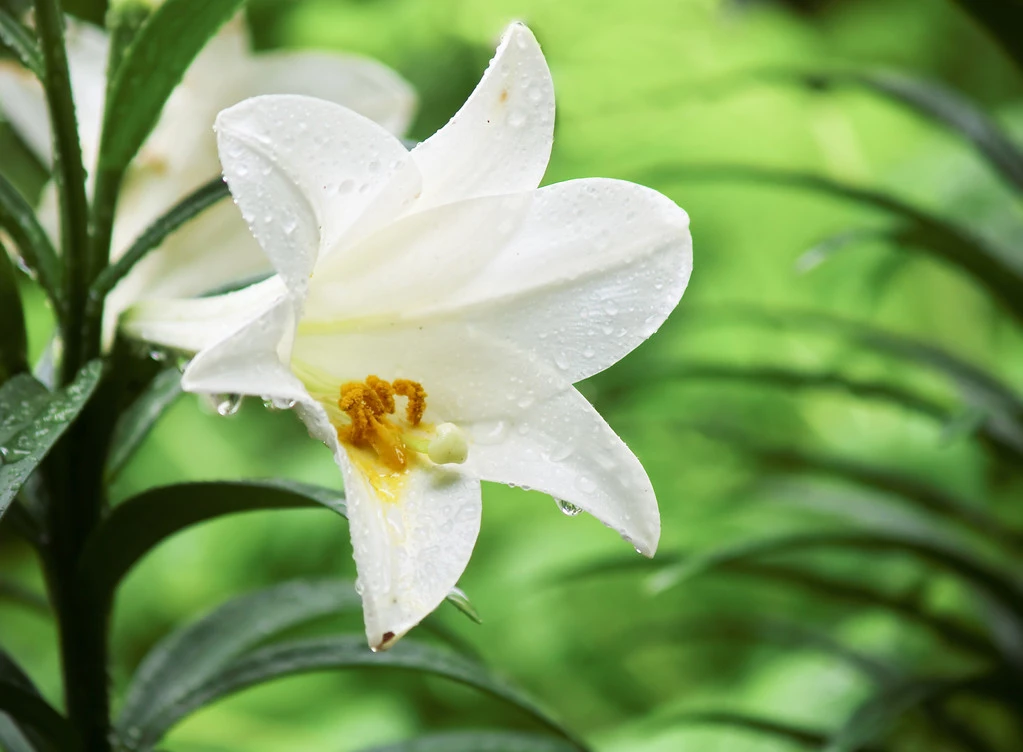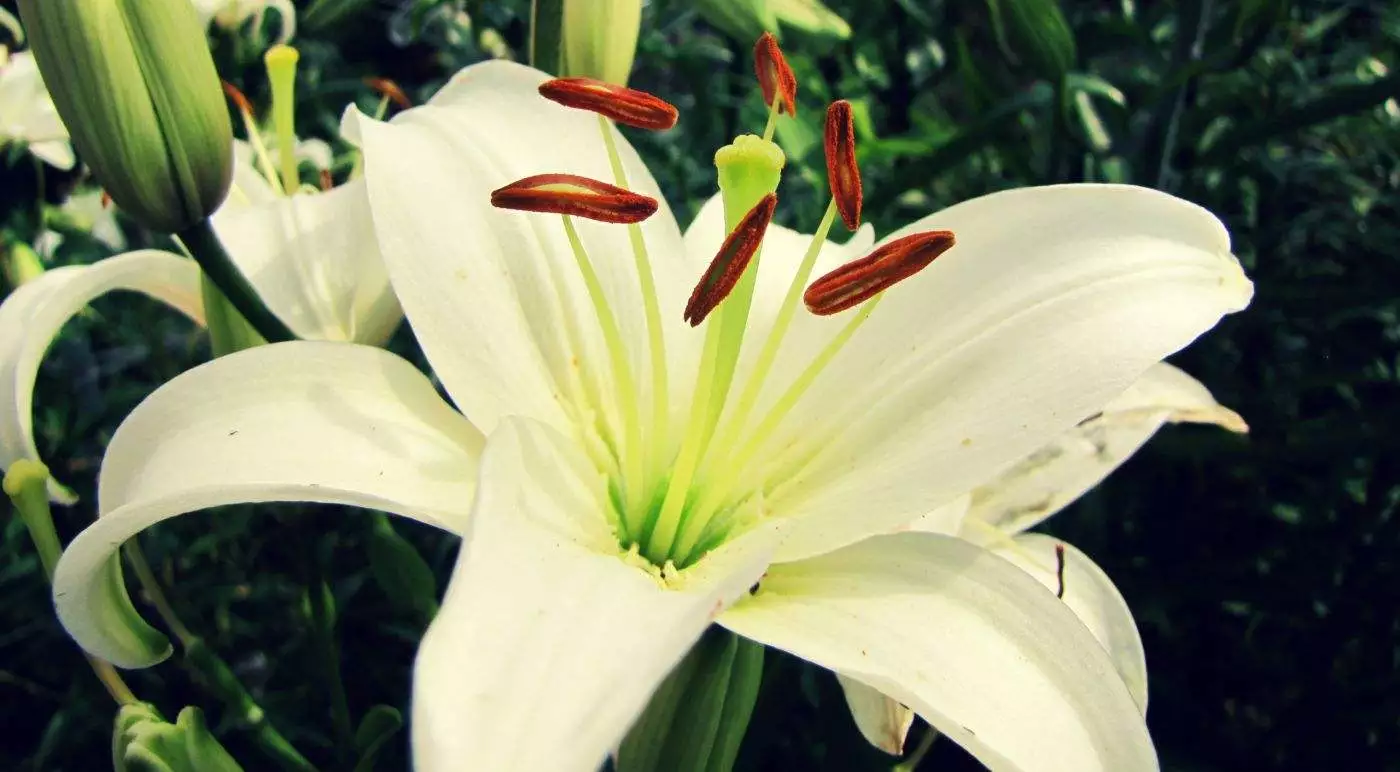How To Grow And Care For Easter Lily (Lilium Longiflorum)
Written by Ivy
Dec 21 2021

Easter lily (Lilium Longiflorum) is 2.5-5cm high, and the petals of Easter Lily are white. The stem of Easter lily is 45-90 cm tall, green and light red at the base. Easter lily is lanceolate or oblong lanceolate, with no hair on both sides. Easter lily flowers are solitary or 2-3. Easter lily flower trumpet shaped, white, slightly green outside the tube. Easter Lily blooms from June to July. Easter lily is an autumn bulbous plant. As a perennial herb, after flowering, Easter lily flowers are pure white and fragrant, giving people a feeling of elegance and purity. It is a very excellent fresh cut bouquet. Let's take a look at the environmental conditions for the conservation of Easter lily.
 Spring is the most suitable time to plant Easter lily. Not only is the sunshine and temperature suitable at this time, but also because planting in this season will see the bud of Easter lily open during the flowering period. If planting later, it will open a little later than other easter lilies, and the later the time, the higher the temperature, it is not suitable for Easter lily to bloom.
Spring is the most suitable time to plant Easter lily. Not only is the sunshine and temperature suitable at this time, but also because planting in this season will see the bud of Easter lily open during the flowering period. If planting later, it will open a little later than other easter lilies, and the later the time, the higher the temperature, it is not suitable for Easter lily to bloom.
If we want Easter lily to be on the market from November to December, we need to start cultivating it around September. First, let Easter lily seed balls undergo anti-corrosion treatment in the flower house at 13 ℃ for 14 days, and then cultivate them in the flower house at 3 ℃ for about 1 month, so that you can see the beautiful flowers and bones of Easter Lily from November to December!
During daily watering, we can observe the soil of Easter lily to see how long it takes for the soil to be watered from permeable to dry, and then make a simple record. There will be different watering times in each season.
Then you can water according to this time. Of course, you should also observe the soil before watering Easter lily. The recorded time is only an auxiliary role. There must be no habitual watering. If you have nothing to do, you want to water Easter lily. Pay attention to the rationality of watering.
Under normal circumstances, Easter lily, which we usually maintain, needs to be exposed to the sun, because it must have a certain degree of photosynthesis in order to grow better. Only after being exposed to the sun before flowering can the flower buds bloom better in the future. The light of Easter lily comes first, so fertilization and water control become the second. Only reasonable watering and appropriate fertilization can make Easter lily blossom better.
The types of fertilizer applied to Easter Lily can also be divided into base fertilizer and fertilizer used in growth period. If it's base fertilizer, use rotten organic fertilizer instead of raw fertilizer. If the fertilizer is applied during the growth period, you can use various organic fertilizers purchased from the store for Easter lily, such as organic fertilizers containing nitrogen, phosphorus and potassium. Nutrition needs to be balanced and diverse. Don't supplement only one element.
Easter lily has to go through a trim before inserting, cutting the bottom obliquely. After insertion, trim regularly, and cut the bottom one to two centimeters obliquely. For native plants, we'd better cut them obliquely, leaving three or four buds at the base of the cut branches.
If we carry out Easter lily repotting, first remove the plant and the host soil from the original pot, then pull out 1 / 3-1 / 2 of the old soil on the outer layer of the root, and trim it appropriately according to the existing conditions of the root. The main time is to drop old, weak and withered roots, rotten roots, empty roots, winding and curling and other bad forms of roots. In this way, it can not only avoid rotten roots after potting, but also stimulate Easter lily to germinate new roots.
However, if the root system of Easter lily is in good condition and there are no bad roots, we can only remove the soil ball at the root of Easter lily, and then use new pots of new soil to plant again. Moreover, we need to keep the earth ball of Easter lily as much as possible. We only need to pull out the surrounding soil and expose the root system as much as possible, which is more conducive to the rapid slow seedling, rooting and survival of Easter lily after it is put into the pot.
It is also known as "latent hidden flower leaf disease of Lily". The specific disease is that there are deep and light brown green spots and dead spots on the leaves. The infected plants grow short, the leaves become smaller and curl at the edge. Occasionally, there are light brown spindle disease spots on the petals, and the flowers are abnormal in shape and can not stretch and open.
Control Method:
The reserved seeds shall be selected from virus-free bulbs, and the prevention and control of aphids, leaf cicadas and other pests shall be done well. Once the disease is infected, the diseased branches shall be pulled out and destroyed immediately.
At the initial stage of the disease, the leaves will grow small brown spots, which may expand into brown spots, with dark brown edges. Then there will be many black spots in the center of the disease spot, which will make the whole leaf black and die.
Control Method:
The diseased leaves were removed and sprayed with 500 times of Daisen zinc wettable powder at 65% concentration to cut off the spread of the virus.
The specific disease is that the bulbs of Lily appear brown spots. In severe cases, all the bulbs turn brown and rot.
Control Method:
At the beginning of the disease, 300 times of mancozeb solution with 50% concentration shall be sprayed.
In the early stage of disease, it is manifested at the tip of the lower part of the leaf, and concentrated on the leaf. Irregular large and small round spots will appear on the diseased leaf, and the color can be divided into light yellow and grayish brown due to different varieties. Leaves that are seriously ill will die.
Control Method:
The cultivation of Easter Lily in greenhouse should ensure ventilation and light transmission and improve the management intensity; When the disease occurs, the diseased leaves shall be removed and sprayed with 800-1000 times of 50% concentration of Tuvalu wettable powder or 1% of the same amount of Bordeaux solution every 7-10 days for 3-4 times.
We can peel the mature and robust Easter lily bulbs from the stem and cut in April. The cutting depth can be slightly exposed at the top. Generally, after 2 ~ 4 months of cutting in spring, most Easter lily bulbs take root and grow leaves, and grow small bulbs on the scale base. At this time, they can be transplanted. It usually takes 3 ~ 4 years to propagate with Easter lily bulbs to flowering.
We can wash the Easter lily bulbs and remove them. We can make cuttings after the wound of Easter lily heals. Put the processed bulbs in a transparent plastic box. In order to promote the production of small bulbs, the temperature can be changed. Put it in the dark for three to five weeks at room temperature, then put it in the refrigerator for three to five weeks, and finally move it back to room temperature for three to five weeks. Wait until Easter lily cuttings and roots, and then plant it in a well drained medium.
Easter Lily Quick InfoWhen to Plant Easter LilyWhen does Easter Lily Bloom & HarvestEaster Lily Care in DetailEaster Lily WateringEaster Lily SoilEaster Lily LightEaster Lily TemperatureEaster Lily HumidityEaster Lily FertilizerEaster Lily PruningEaster Lily RepottingEaster Lily Pest & Disease ControlEaster Lily Propagation From BulbsEaster Lily Benefits
Easter Lily Quick Info
| Botanical/Scientific Name | Lilium Longiflorum |
| Common Name | Easter Lily |
| When to Grow/Bloom/Harvest | Plant in the fall or very early spring/Bloom each year |
| Uses | Treatment for ovarian cysts |
| Origin | Ryukyu Islands in southern Japan |
| Light Care | Bright, indirect natural light |
| Soil Care | Well-drained soil |
| Temperature Care | 60 to 65 degrees |
| Humidity Care | Around 40% relative humidity |
| Watering | Watered freely during the active growth period |
| Pruning Care | Remove brown stems |
| Fertilizer Care | A liquid houseplant fertilizer every two weeks |
| Propagation | Grown from Bulbs |
| Toxic | Poisonous |
| Flower Color | White or white with faint pink streaks |
When to Plant Easter Lily

When does Easter Lily Bloom & Harvest
If we want Easter lily to bloom from October to November, we will start planting balls around August, Before planting bulbs, Easter lily should be treated with anti-corrosion treatment (using a large ball of 40 days to carry out anti-corrosion treatment at 13 ℃ to 15 ℃), and then placed in a flower house at 8 ℃ for 30 days. When the new buds grow and grow to about 5cm, they can be planted. Finally, it can be cultured for about a month to ensure that we can get flowers in October.If we want Easter lily to be on the market from November to December, we need to start cultivating it around September. First, let Easter lily seed balls undergo anti-corrosion treatment in the flower house at 13 ℃ for 14 days, and then cultivate them in the flower house at 3 ℃ for about 1 month, so that you can see the beautiful flowers and bones of Easter Lily from November to December!
Easter Lily Care in Detail
Easter Lily Watering
Easter Lily can't stand drought. If it is too dry, its growth will be weak. Watering should keep the soil moist. We can supply water every 3-5 days to maintain the growth demand of Easter lily. In cold weather, evaporation can be reduced and watering can also be reduced.During daily watering, we can observe the soil of Easter lily to see how long it takes for the soil to be watered from permeable to dry, and then make a simple record. There will be different watering times in each season.
Then you can water according to this time. Of course, you should also observe the soil before watering Easter lily. The recorded time is only an auxiliary role. There must be no habitual watering. If you have nothing to do, you want to water Easter lily. Pay attention to the rationality of watering.
Easter Lily Soil
Because the roots of Easter Lily are fleshy bulbs, we need to choose a thick and good sandy loam for Easter lily to maintain in order to make Easter lily grow more vigorously. There are many varieties of lily, and some of them can grow in soil with pH value of about 6 to 7, so that they can grow well. In addition, before planting Easter lily, we need to apply some compound fertilizer at the bottom of Easter lily.Easter Lily Light
When we plant Easter lily, we all know that Easter lily is a ball seed, not like other flowers, most of which are granular seeds. So when we just planted, I didn't recommend taking the planted Easter lily seed ball to the sun, because the hot weather will affect its germination. So after germinating as much as possible, we will gradually increase the light for Easter lily.Under normal circumstances, Easter lily, which we usually maintain, needs to be exposed to the sun, because it must have a certain degree of photosynthesis in order to grow better. Only after being exposed to the sun before flowering can the flower buds bloom better in the future. The light of Easter lily comes first, so fertilization and water control become the second. Only reasonable watering and appropriate fertilization can make Easter lily blossom better.

Easter Lily Temperature
The growth and flowering temperature of Easter lily is 16-24 ℃, and the growth almost stops when it is lower than 5 ℃ or higher than 30 ℃. Easter lily only grows normally when it is higher than 10 ℃, and the growth stops when it is higher than 25 ℃. If the temperature at night in winter is lower than 5 ℃ for 5-7 days, the flower bud differentiation and flower bud development will be seriously affected, delaying the flowering and even flower cracking of Easter lily. When the temperature is lower than 11C after emergence, the growth is inhibited, and the seedlings are vulnerable to freezing injury below 3. Easter lily is well developed with a daily average temperature of 24-28 ℃ during flowering. The growth was inhibited when the temperature was higher than 28 ℃. The temperature continues to be higher than 33, and the plants turn yellow and even die. Easter Lily likes light in the early and middle stages of growth and is afraid of high temperature in the later stage. It generally grows poorly in high temperature areas.Easter Lily Humidity
Every time we adjust the humidity of Easter lily, we should exchange the positions of the incubator up, down, left and right, so that the temperature and humidity conditions of the culture materials are uniform. At the same time, place the incubator in the water tank every 7-8 days, and wash away Easter lily mucus or miscellaneous bacteria with tap water in time. Because the scales are washed and elutriated many times, and the ground is washed with tap water from time to time, there is no need to increase the humidity in the culture room.Easter Lily Fertilizer
Easter lily still has high requirements for fertilization, and the time period for fertilization is also relatively long. When Easter Lily was just planted and during the growth period of Easter lily, that is, from spring to autumn, an appropriate amount of fertilizer can be applied.The types of fertilizer applied to Easter Lily can also be divided into base fertilizer and fertilizer used in growth period. If it's base fertilizer, use rotten organic fertilizer instead of raw fertilizer. If the fertilizer is applied during the growth period, you can use various organic fertilizers purchased from the store for Easter lily, such as organic fertilizers containing nitrogen, phosphorus and potassium. Nutrition needs to be balanced and diverse. Don't supplement only one element.

Easter Lily Pruning
Easter lily pruning has two main purposes. First, Easter lily pruning can make the shape of the plant more beautiful and improve its ornamental. Second, Easter lily pruning can cut off the diseased, dead and thin branches, or trim them after flowering, which can make the plant grow more vigorously and improve its life span.Easter lily has to go through a trim before inserting, cutting the bottom obliquely. After insertion, trim regularly, and cut the bottom one to two centimeters obliquely. For native plants, we'd better cut them obliquely, leaving three or four buds at the base of the cut branches.
Easter Lily Repotting
On the one hand, Easter lily repotting can solve the problem of insufficient space in the basin, on the other hand, it can also solve the problem of hardening of basin soil and insufficient nutrients. To change the pot and soil for Lily is to change a more suitable space in the pot for its growth. In addition, during the growth period, it is usually recommended to turn the basin at an appropriate time, so that Easter Lily can receive light more evenly and fully in all directions, so as to avoid Easter lily growing in one direction and affecting its beauty.If we carry out Easter lily repotting, first remove the plant and the host soil from the original pot, then pull out 1 / 3-1 / 2 of the old soil on the outer layer of the root, and trim it appropriately according to the existing conditions of the root. The main time is to drop old, weak and withered roots, rotten roots, empty roots, winding and curling and other bad forms of roots. In this way, it can not only avoid rotten roots after potting, but also stimulate Easter lily to germinate new roots.
However, if the root system of Easter lily is in good condition and there are no bad roots, we can only remove the soil ball at the root of Easter lily, and then use new pots of new soil to plant again. Moreover, we need to keep the earth ball of Easter lily as much as possible. We only need to pull out the surrounding soil and expose the root system as much as possible, which is more conducive to the rapid slow seedling, rooting and survival of Easter lily after it is put into the pot.
Easter Lily Pest & Disease Control
- Mosaic Disease
It is also known as "latent hidden flower leaf disease of Lily". The specific disease is that there are deep and light brown green spots and dead spots on the leaves. The infected plants grow short, the leaves become smaller and curl at the edge. Occasionally, there are light brown spindle disease spots on the petals, and the flowers are abnormal in shape and can not stretch and open.
Control Method:
The reserved seeds shall be selected from virus-free bulbs, and the prevention and control of aphids, leaf cicadas and other pests shall be done well. Once the disease is infected, the diseased branches shall be pulled out and destroyed immediately.
- Spot Disease
At the initial stage of the disease, the leaves will grow small brown spots, which may expand into brown spots, with dark brown edges. Then there will be many black spots in the center of the disease spot, which will make the whole leaf black and die.
Control Method:
The diseased leaves were removed and sprayed with 500 times of Daisen zinc wettable powder at 65% concentration to cut off the spread of the virus.
- Bulb Rot
The specific disease is that the bulbs of Lily appear brown spots. In severe cases, all the bulbs turn brown and rot.
Control Method:
At the beginning of the disease, 300 times of mancozeb solution with 50% concentration shall be sprayed.
- Leaf blight
In the early stage of disease, it is manifested at the tip of the lower part of the leaf, and concentrated on the leaf. Irregular large and small round spots will appear on the diseased leaf, and the color can be divided into light yellow and grayish brown due to different varieties. Leaves that are seriously ill will die.
Control Method:
The cultivation of Easter Lily in greenhouse should ensure ventilation and light transmission and improve the management intensity; When the disease occurs, the diseased leaves shall be removed and sprayed with 800-1000 times of 50% concentration of Tuvalu wettable powder or 1% of the same amount of Bordeaux solution every 7-10 days for 3-4 times.

Easter Lily Propagation From Bulbs
During the growth of Easter lily bulbs, new bulbs are gradually formed on the stem axis. Generally, 1 ~ 3 or more bulbs can be divided after one year of cultivation. Easter lily bulbs can be planted in the spring of the second year after harvest in autumn, or in deep soil in the autumn of that year.We can peel the mature and robust Easter lily bulbs from the stem and cut in April. The cutting depth can be slightly exposed at the top. Generally, after 2 ~ 4 months of cutting in spring, most Easter lily bulbs take root and grow leaves, and grow small bulbs on the scale base. At this time, they can be transplanted. It usually takes 3 ~ 4 years to propagate with Easter lily bulbs to flowering.
We can wash the Easter lily bulbs and remove them. We can make cuttings after the wound of Easter lily heals. Put the processed bulbs in a transparent plastic box. In order to promote the production of small bulbs, the temperature can be changed. Put it in the dark for three to five weeks at room temperature, then put it in the refrigerator for three to five weeks, and finally move it back to room temperature for three to five weeks. Wait until Easter lily cuttings and roots, and then plant it in a well drained medium.
Easter Lily Benefits
- Easter lily is non-toxic
- Easter Lily's viewing value
- Easter Lily can purify the air
Latest Updated
- Benefits of Bugleweed - 7 Science-backed Health Benefits
- Bugleweed Dangers & Side Effects - Is It Poisonous?
- How to Plant Evergreen Trees - What You Should Know
- When to Plant Evergreens - Grow Guide for Evergreen Trees
- 12 Wonderful Evergreen Shrubs for Your Garden
- 12 Popular Evergreen Plants with Pictures for Beginners
- When And How To Prune A Lilac Bush Like a Pro
- How to Grow & Care for Lilac Vine (Hardenbergia Violacea)
- Japanese Lilac Tree (Syringa Reticulata) Care & Propagation Guide
- Shumard Oak Pros and Cons - What to Know
Popular Articles
- Winter maintenance of Antirrhinum Majus
- How to Grow Terminalia Mantaly Tree
- How to Grow and Care for Crossostephium Chinense
- How to grow Antirrhinum Majus in spring
- Peristeria Elata (Dove Orchid) Profile: Info & Care Guide
- Underwatered Snake Plant (Sansevieria Trifasciata) - Signs And How To Fix
- How to Care for Brazilian Jasmine Plant (Mandevilla Sanderi)
- How to Grow & Care for Graptopetalum Purple Delight in Summer
- Rosa Chinensis (China Rose): Plant Growing & Care Tips
- How to Care for Baby Sun Rose (Aptenia Cordifolia)